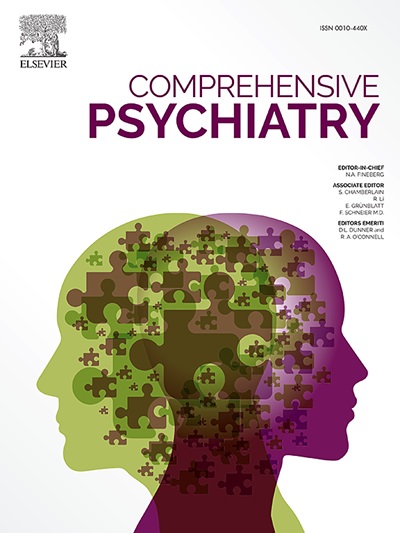Gaming disorder among Swedish adolescents: Measurement, risk factors, and classification
IF 4.2
2区 医学
Q1 PSYCHIATRY
引用次数: 0
Abstract
Objectives
This study examined the 1) psychometric properties of an independently translated Swedish version of the gaming disorder test (GDT) among Swedish adolescents based on two psychometric theories, 2) measurement invariance across age (i.e., 15 vs 16–17), gender (i.e., males vs females), and gaming time (i.e., < 2 h vs ≥ 2 h), and 3) factors that predict gaming disorder. The findings will help researchers understand and ascertain the use of the GDT among Swedish adolescents.
Methods
A total of 5320 Swedish adolescents were recruited and responded to measures including gaming disorder, gaming duration, sleep duration, physical activity, mental well-being, and self-esteem. Statistical analyses were conducted using confirmatory factor analysis, regression analysis, latent class analysis, classical test theory, and Rasch analysis.
Results
Satisfactory and unidimensional psychometric properties for the independently translated Swedish version of the GDT were found. Specifically, the factor structure, internal consistencies, separation reliability and separation index were supported, but not the person separation reliability and index. Also, the GDT was invariant across ages but only partially so across gender and gaming time. The GDT can classify adolescents as having a high or low risk of gaming disorder. Lastly, factors that predicted gaming disorder were poorer mental well-being and longer gaming time among males and low physical activity and longer gaming time among females.
Conclusion
Due to its conciseness, researchers may use the independently translated Swedish version of the GDT for screening people for gaming issues even in busy settings like schools. Moreover, attention must be paid to males, those with poorer mental well-being, those who are physically inactive, and those with a longer gaming time to help curb gaming disorder. Future research may focus on examining the test-retest reliability and clinical validity of the GDT among adolescents.
瑞典青少年的游戏障碍:测量、危险因素和分类
本研究基于两种心理测量理论检验了1)瑞典青少年独立翻译的游戏障碍测试(GDT)的心理测量特性;2)不同年龄(即15岁vs 16-17岁)、性别(即男性vs女性)、游戏时间(即2小时vs≥2小时)的测量不变性;3)预测游戏障碍的因素。这些发现将有助于研究人员了解和确定瑞典青少年使用GDT的情况。方法共招募了5320名瑞典青少年,并对游戏障碍、游戏持续时间、睡眠时间、身体活动、心理健康和自尊进行了评估。统计分析采用验证性因子分析、回归分析、潜在类分析、经典检验理论和Rasch分析。结果独立翻译的瑞典语版GDT具有令人满意的单维心理测量特性。其中,因子结构、内部一致性、分离信度和分离指标得到支持,但不支持人的分离信度和分离指标。此外,GDT在不同年龄段是不变的,但在性别和游戏时间上是部分不变的。GDT可以将青少年分为高或低风险的游戏障碍。最后,预测游戏障碍的因素是男性较差的心理健康状况和较长的游戏时间,以及女性较少的身体活动和较长的游戏时间。由于GDT的简洁性,即使在学校等繁忙的环境中,研究人员也可以使用独立翻译的瑞典语GDT来筛查人们的游戏问题。此外,必须关注男性,那些心理健康状况较差的人,那些身体不活跃的人,以及那些玩游戏时间较长的人,以帮助遏制游戏障碍。未来的研究重点应放在青少年GDT的重测信度和临床效度上。
本文章由计算机程序翻译,如有差异,请以英文原文为准。
求助全文
约1分钟内获得全文
求助全文
来源期刊

Comprehensive psychiatry
医学-精神病学
CiteScore
12.50
自引率
1.40%
发文量
64
审稿时长
29 days
期刊介绍:
"Comprehensive Psychiatry" is an open access, peer-reviewed journal dedicated to the field of psychiatry and mental health. Its primary mission is to share the latest advancements in knowledge to enhance patient care and deepen the understanding of mental illnesses. The journal is supported by a diverse team of international editors and peer reviewers, ensuring the publication of high-quality research with a strong focus on clinical relevance and the implications for psychopathology.
"Comprehensive Psychiatry" encourages authors to present their research in an accessible manner, facilitating engagement with clinicians, policymakers, and the broader public. By embracing an open access policy, the journal aims to maximize the global impact of its content, making it readily available to a wide audience and fostering scientific collaboration and public awareness beyond the traditional academic community. This approach is designed to promote a more inclusive and informed dialogue on mental health, contributing to the overall progress in the field.
 求助内容:
求助内容: 应助结果提醒方式:
应助结果提醒方式:


